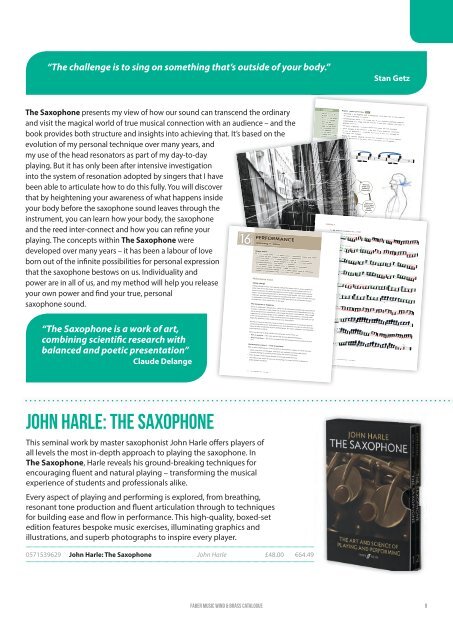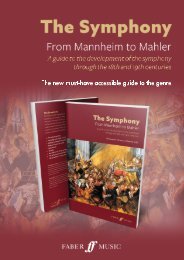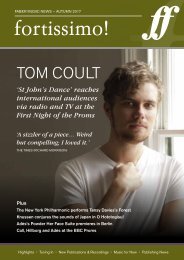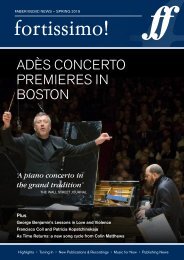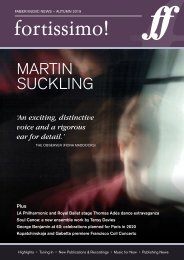The Saxophone Is Your Voice by John Harle
Master saxophonist John Harle talks about how to create the perfect saxophone sound, by likening the sound creation to that of the human voice.
Master saxophonist John Harle talks about how to create the perfect saxophone sound, by likening the sound creation to that of the human voice.
Create successful ePaper yourself
Turn your PDF publications into a flip-book with our unique Google optimized e-Paper software.
122 THE SAXOPHONE: VOLUME 2<br />
“<strong>The</strong> challenge is to sing on something that’s outside of your body.”<br />
Stan Getz<br />
<strong>The</strong> <strong>Saxophone</strong> presents my view of how our sound can transcend the ordinary<br />
and visit the magical world of true musical connection with an audience – and the<br />
book provides both structure and insights into achieving that. It’s based on the<br />
evolution of my personal technique over many years, and<br />
my use of the head resonators as part of my day-to-day<br />
playing. But it has only been after intensive investigation<br />
into the system of resonation adopted <strong>by</strong> singers that I have<br />
been able to articulate how to do this fully. You will discover<br />
that <strong>by</strong> heightening your awareness of what happens inside<br />
your body before the saxophone sound leaves through the<br />
instrument, you can learn how your body, the saxophone<br />
and the reed inter-connect and how you can refine your<br />
playing. <strong>The</strong> concepts within <strong>The</strong> <strong>Saxophone</strong> were<br />
developed over many years – it has been a labour of love<br />
born out of the infinite possibilities for personal expression<br />
that the saxophone bestows on us. Individuality and<br />
power are in all of us, and my method will help you release<br />
your own power and find your true, personal<br />
saxophone sound.<br />
“<strong>The</strong> <strong>Saxophone</strong> is a work of art,<br />
combining scientific research with<br />
balanced and poetic presentation”<br />
Claude Delange<br />
16<br />
PERFORMANCE<br />
Transcending the ordinary<br />
Chapter outline<br />
This section touches briefly on some general aspects of performance, analyzes what happens<br />
as we perform, and gives strategies for preparation and performance:<br />
• Performance vision – ideas for creating personal models for your performance<br />
• Performance style – some practical thoughts about ou role as instrumental soloists<br />
• Unlocking performance – what happens as we perform?<br />
• <strong>The</strong> performance system – practical aspects of preparation and performance<br />
• Music as words – pacing your playing to engage your audience<br />
• Practice and performance strategies how to practise specific pieces for performance<br />
• Adrenalin and performance anxiety – how to cope under pressure.<br />
Performance vision<br />
Taking charge<br />
Taking charge of your own playing and performance style is more important<br />
today than it ever has been. As many of the old certainties about careers in<br />
music evaporate, the shifting goalposts of the modern musical world require<br />
today’s successful saxophonists to be focused and flexible. This new musical<br />
landscape provides opportunities for saxophonists with a vision of their own and<br />
an approach to performance that will fulfill your musical and personal goals,<br />
perhaps even more easily than in the past.<br />
<strong>The</strong> musician as magician<br />
From an audience’s perspective, a first-rate professional saxophonist can perform<br />
miracles. A breath is taken from the air and is transformed immediately into the<br />
warm and generous sound that comes from the player’s instrument. That sound<br />
represents a world of magic to the audience, who have come to a musical event<br />
to be transported into an realm of enchantment and fascination. But how can we<br />
begin the adventure that could lead us to be that player?<br />
Having a vision of what you want to achieve as a performer is essential. Stylistic<br />
and musical choices are individual to you, but the closer you get to your personal<br />
vision of what constitutes a great performance, the more authentic and enjoyable<br />
your experience will be.<br />
Here are two tips to help clarify your personal vision. <strong>The</strong>y are:<br />
• How to perform – the style and sound of your ideal performance<br />
• What to perform – the music or genre that will inspire you to perform at your<br />
best.<br />
Performance vision 1 – how to perform<br />
This is very simple advice. Put yourself in the audience’s place. Try this exercise:<br />
• Close your eyes and imagine yourself<br />
in an audience, hearing and seeing<br />
yourself playing in an ideal performance ten years from now.<br />
• This ‘fantasy’ performance deeply moves and impresses you.<br />
• Don’t limit this vision in any way <strong>by</strong> relating it to your current technical or<br />
performance standard.<br />
!<br />
REMINDERS<br />
• Play the exercise at<br />
60 bpm.<br />
• Do not use your tongue<br />
to star the exercise.<br />
• Relax your jaw.<br />
• Alternate between<br />
single- and fu l doublelip<br />
embouchure with<br />
each repetition.<br />
• Use the practice wheel<br />
to change focus as you<br />
practise. with the<br />
<br />
<br />
Repeat,<br />
focusing on<br />
placement<br />
of first note<br />
Focus on:<br />
Point of Primary<br />
Resonance<br />
Focus on:<br />
Undulation in<br />
low abdomen<br />
Register 3 upper power lines Alto<br />
• Referring to the diagram, pull an imaginary elastic line back inwards towards<br />
the point of primary resonance.<br />
• Simultaneously focus on the lowest part of your abdomen pushing outwards,<br />
compressing your lungs with the muscles of your back, ending at the point of<br />
primary resonance.<br />
• <strong>The</strong> point of primary resonance should feel active, soft and powerful.<br />
• Sense changes in the vibrations at the back of your head and undulation<br />
in your low abdomen in a wave-like movement as you move through the<br />
chromatic note changes.<br />
• Repeat the exercise, ‘placing’ the first note correctly as you become familiar<br />
with the sensations of the power lines in the upper part of register 3.<br />
<br />
<br />
EXERCISE 9<br />
<br />
<br />
Prepare<br />
Power<br />
Start Up<br />
Register 3<br />
(High)<br />
Power Lines<br />
<br />
Focus on:<br />
Vibration<br />
changes in<br />
back of head<br />
h = 96 INCREASE GRADUALLY TO h = 112<br />
116 THE SAXOPHONE: VOLUME 2<br />
Alternate<br />
single- and<br />
double-lip<br />
embouchure<br />
Pull in low<br />
back of head<br />
and push out<br />
lowest<br />
abdomen<br />
<br />
<br />
<br />
<br />
<br />
TA TU TU TU KU TU KU<br />
TU KA TA KU (sim. ...)<br />
<br />
<br />
<br />
<br />
<br />
<br />
<br />
<br />
<br />
<br />
<br />
TA KU TU TU<br />
KU TA (sim. ...)<br />
3<br />
3 3 3<br />
3 3<br />
<br />
<br />
<br />
<br />
<br />
<br />
<br />
<br />
<br />
<br />
<br />
3 3<br />
<br />
<br />
<br />
<br />
<br />
<br />
<br />
<br />
<br />
<br />
<br />
<br />
<br />
<br />
<br />
3<br />
<br />
<br />
<br />
<br />
<br />
3<br />
<br />
<br />
<br />
<br />
<br />
<br />
<br />
<br />
<br />
<br />
<br />
<br />
<br />
<br />
<br />
<br />
<br />
<br />
<br />
<br />
<br />
<br />
<br />
<br />
<br />
<br />
<br />
<br />
<br />
<br />
<br />
<br />
<br />
<br />
<br />
<br />
<br />
<br />
<br />
3<br />
<br />
<br />
<br />
<br />
<br />
<br />
<br />
<br />
<br />
<br />
<br />
<br />
3<br />
<br />
<br />
<br />
<br />
<br />
<br />
<br />
<br />
<br />
<br />
<br />
3<br />
<br />
<br />
<br />
<br />
(TA)<br />
<br />
<strong>John</strong> <strong>Harle</strong>: <strong>The</strong> <strong>Saxophone</strong><br />
This seminal work <strong>by</strong> master saxophonist <strong>John</strong> <strong>Harle</strong> offers players of<br />
all levels the most in-depth approach to playing the saxophone. In<br />
<strong>The</strong> <strong>Saxophone</strong>, <strong>Harle</strong> reveals his ground-breaking techniques for<br />
encouraging fluent and natural playing – transforming the musical<br />
experience of students and professionals alike.<br />
Every aspect of playing and performing is explored, from breathing,<br />
resonant tone production and fluent articulation through to techniques<br />
for building ease and flow in performance. This high-quality, boxed-set<br />
edition features bespoke music exercises, illuminating graphics and<br />
illustrations, and superb photographs to inspire every player.<br />
0571539629 <strong>John</strong> <strong>Harle</strong>: <strong>The</strong> <strong>Saxophone</strong> <strong>John</strong> <strong>Harle</strong> £48.00 €64.49<br />
Faber Music wind & brass Catalogue<br />
9


